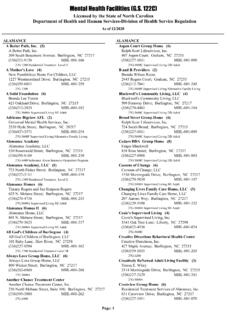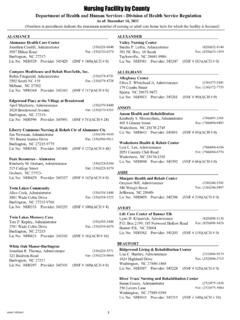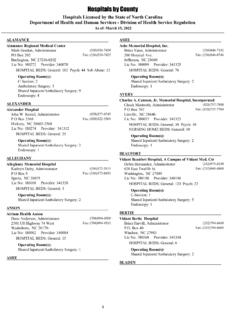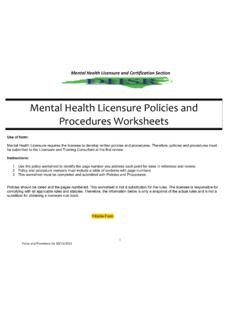Transcription of Handout #1 - Passive Range of Motion Exercises
1 Module 16 Restorative Care Handout #1 - Passive Range of Motion Exercises Passive Range of Motion Exercises Care Guide Range of Motion Exercises are also called ROM Exercises . ROM Exercises may be active or Passive . Active ROM is performed when a person can do the Exercises by himself. Active- assisted ROM Exercises are performed by the person and a helper. Passive ROM Exercises are performed for a person by a helper. The helper does the ROM Exercises because the person cannot perform them by himself. Do not perform Passive ROM Exercises on a person without being instructed to by your supervisor. Why is it important to do Passive ROM Exercises ?
2 ROM Exercises are important if the patient must stay in bed or in a wheelchair. ROM Exercises help keep their joints and muscles as healthy as possible. Without these Exercises , blood flow and flexibility (moving and bending) of the joints can decrease. Joints, such as knees and elbows, can become stiff and locked without ROM Exercises . Passive ROM Exercises help keep joint areas flexible, but do not build up muscles or make them stronger. How do I get started? Learn Passive ROM Exercises from your supervisor. Practice the Exercises with your supervisor first. Your supervisor can make sure you are doing the Exercises correctly.
3 Your supervisor can also show you the easiest way to do the Exercises , so you do not get hurt or fatigued. Raise the person's bed to a height that is comfortable for you. This will help keep you from hurting your back or other muscles. Make sure the wheels of the bed or wheelchair are locked before you start the Exercises . Do all ROM Exercises smoothly and gently. Never force, jerk, or over-stretch a muscle. This can hurt the muscle or joint instead of helping. Move the joint slowly. This is especially important if the person has muscle spasms (tightening). Move the joint only to the point of resistance. This is the point where you cannot bend the joint any further.
4 Put slow, steady pressure on the joint until the muscle relaxes. Stop ROM Exercises if the person feels pain. Ask the person to tell you right away if he feels any pain. Watch for signs of pain if the person is unable to talk. The Exercises should never cause pain or go beyond the normal movement of that joint. Make ROM Exercises a part of the person's daily routine. ROM Exercises should be indicated on the person's plan of care. Do ROM Exercises at the same time every day. Do them while bathing the person or while the person watches TV. This will make the time go faster and help the person be more relaxed. You may want to break the exercise program into 2 or 3 sessions.
5 You can then do the sessions at various times of the day instead of doing them all at once. NCDHHS/DHSR/HCPEC | Home Care Aide Curriculum | July 2021 Module 16-7. Module 16 Restorative Care Follow your supervisor's orders. Your supervisor will tell you how many times per day you should do ROM Exercises . Your supervisor will also tell you how many repetitions (number of times) you should perform Exercises on each joint. How are Passive ROM Exercises performed? Perform the Exercises in the same order to keep it simple and easy to remember. Start Exercises at the person's head and work down toward his toes. Use good posture while doing ROM Exercises for the person.
6 Standing or sitting as straight as possible will help your breathing while doing the Exercises . It will also make your back, neck, and stomach muscles stronger. Keep your stomach muscles tight and pull your hips into a straight line under your shoulders. Leave the person in a comfortable position after you finish each exercise. Always wash your hands before and after doing ROM Exercises for a person. Head and Neck Exercises : How to start: Lay the person on his back with his head as flat (no pillow) as possible. Support the back of the person's head with one of your hands. Support the chin with your other hand. Chin-to-chest. Raise the back of the person's head up from the bed.
7 Gently tip his chin toward his chest. Try to rest the person's chin on his chest if possible. Head turns. Put one hand on each side of the person's face. Turn the person's head toward the right as if he were looking over his right shoulder. Next, slowly turn the person's head so he is looking over his left shoulder. Turn the head only far enough so that the person's nose is lined up above their shoulder. Head tilts. Put one of your hands on each side of the person's face. Tilt the head to the side, bringing the right ear toward the right shoulder. Next, slowly tilt the person's head to bring the left ear toward the left shoulder.
8 Shoulder and Elbow Exercises : How to start: Put one hand under the person's elbow and hold his wrist with your other hand. Keep the person's elbow straight or bend the elbow slightly if necessary. Shoulder movement, up and down. Turn the person's palm in toward the body. Bring the right arm forward and upward over the person's head until the inner arm touches his ear. Bring the arm back down to his side. Shoulder movement, side to side. Raise the right arm out to the side to shoulder level. Raise it upward over the person's head as far as possible. Bring the arm back down to his side and then swing across the body toward the left shoulder.
9 Swing the arm back down to his side. Shoulder rotation (ro-TAY-shun). Bring the right arm out to the person's side. Bend the elbow so the thumb and fingers are pointing up. Rotate (turn) the arm so the thumb and fingers point down toward the person's toes. Elbow bends, up and down. With the person's right arm at his side, turn the palm of his hand face up. Bend the arm at the elbow so that the fingers are pointing toward the NCDHHS/DHSR/HCPEC | Home Care Aide Curriculum | July 2021 Module 16-8. Module 16 Restorative Care ceiling. If possible, continue bending the elbow and touch the hand (fingertips) to the front of the right shoulder.
10 Move the hand back down to the person's side. Elbow bends, side to side. Hold the right arm out at shoulder level with the palm facing up. Bend the elbow. Try to make the person's fingertips touch the top of his right shoulder. Repeat the above Exercises with the left arm. Forearm and Wrist Exercises : How to start: Start with the person's arms at his sides. Hold just below the person's wrist with one of your hands. Hold the person's hand with your other hand. Wrist rotation. Hold the wrist and hand of the right arm with the palm face down. Keeping his elbow on the bed, lift the forearm up. Hold the hand and bend it back toward the wrist.













